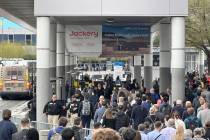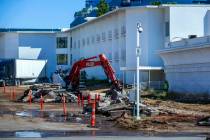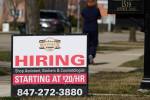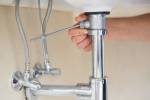Nevada, Las Vegas unemployment declines slightly
It's noteworthy that Nevada's unemployment rate fell in October to its lowest level in more than three years.
Perhaps more importantly, though, wages are on the rise, and that could signal more hiring in coming months, observers say.
First, about that jobless rate: Unemployment fell statewide to 11.5 percent in October, down from 11.8 percent in September and 13.4 percent in October 2011, according to a Monday report from the state Department of Employment, Training and Rehabilitation. It was the state's lowest jobless level since May 2009.
The rate in Las Vegas dipped to 11.1 percent, down from 11.5 percent a month earlier and 13.6 percent a year earlier.
Bill Anderson, chief economist for the employment department, called the numbers "pretty decent." Some of the report's best news was that unemployment fell because jobs increased, not because workers left the labor force, Anderson said. Nevada's employers added 4,700 positions from September to October, nearly double the period's standard gain of 2,500 jobs and more than enough to absorb the 1,000 people who entered the workforce. In the first 10 months of 2012, private-sector payrolls were up 11,100 over the same period in 2011.
To be sure, Nevada has a lot of ground to make up. Employment is down by 157,000 from the start of the recession in December 2007. In the decade before 2007, Nevada added about 400,000 jobs.
No one is predicting a quick return to those heady days, but Monday's numbers do hint at potential hiring gains in coming months.
Average weekly wages across Nevada rose to $830 in the first six months of 2012, a 2.6 percent gain compared with $809 in the same period of 2011. And in Las Vegas, weekly private-sector earnings jumped to $690.75 in September, up 4.3 percent from $662.32 a year earlier, according to figures from local research firm Applied Analysis.
Wages rise for two key reasons: Companies assign workers more hours on the job, or they raise pay to recruit and retain employees. Brian Gordon, a principal in Applied Analysis, said his company's numbers indicate both are happening. Not only are actual hourly wages up, but so are hours worked per week. Private-sector employees averaged 34.4 hours a week in September, up from 33.4 hours a week in September 2011.
Local workers may not be feeling the pay gains, Anderson said, because inflation ran at 2.4 percent in the first half of 2012 and ate away at wages.
But the bigger picture is that "employers are finding reasons to invest more in their human resources," Gordon said. "That means they're experiencing increased revenue and demand from their customer base."
Businesses typically boost wages and hours worked before they start bringing on new full-time workers, said Steve Brown, director of the Center for Business and Economic Research at the University of Nevada, Las Vegas.
"When firms find they can't push up hours worked anymore, they have to reach out and hire more employees," Brown said. "And if firms are having to pay higher wages to find employees, that's an indication that demand (for workers) is growing faster than supply."
How long it will take for improving pay and hours translate into more jobs depends partly on the "fiscal cliff" debate in Washington. Uncertainty about taxes and federal budgets may be keeping some companies on the hiring sidelines, and if Congress goes for yet another six-month spending resolution rather than a longer-term fix, hiring may continue to under-perform, Brown said.
Still, long-range hiring trends look mostly positive, albeit only slightly so, Anderson said.
"The labor markets have been on the mend since early 2011, when job growth turned positive and the unemployment rate started trending down," he said. "Looking forward and putting October in context, we see the labor market showing continued modest improvement. But the fact that we're starting to see better signs, yet we're still sitting on an 11.5 percent unemployment rate, is reflective of just how hard we were hit by the recession. We're starting to see good news, but we have a long way to go."
The state's unemployment rate remains well above the national rate, which was 7.9 percent in October. Nevada has led the nation in joblessness since May 2010. The unemployment rate in Nevada jumps to more than 21 percent if you include discouraged workers who have left the labor force and underemployed part-timers who want full-time jobs.
Contact reporter Jennifer Robison at jrobison@reviewjournal.com or 702-380-4512. Follow @J_Robison1 on Twitter.























